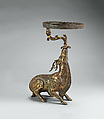Returned to lender The Met accepts temporary loans of art both for short-term exhibitions and for long-term display in its galleries.
Lamp in the Shape of a Deer
Western Han dynasty (206 BCE–9 CE)
Not on view
One of a pair, this lamp was excavated from the area of a princely tomb that housed bathroom utensils. Judging by its long neck and mane, this deer probably represents the mi species, or Père David’s deer, which populated northern China in antiquity but has since gone extinct. The tray would have been filled with an animal- or plant-based fuel, and a hemp stem was plugged onto each of the three spikes, to be lit as a wick. Two lumps of beeswax were found together with this lamp, providing evidence of its use as lighting fuel in the Han dynasty.
#210. Lamp in the form of a deer
Due to rights restrictions, this image cannot be enlarged, viewed at full screen, or downloaded.
This artwork is meant to be viewed from right to left. Scroll left to view more.



